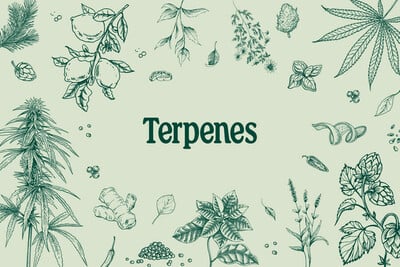.

How Much Of Each Terpene Is In Cannabis?
Terpenes provide much more than just an amazing aroma. They can change the psychoactive and therapeutic effect of a cultivar as well. Therefore, it's important to learn how to tell which terpenes exist in which strains.
Contents:
The best seed banks out there provide growers with in-depth information regarding their selection of cannabis strains. They release data concerning height, yield, and flowering time. Many companies also offer laboratory results that detail the cannabinoid profile of each strain. Accurate percentages let growers know precisely how much THC and CBD their flowers are going to contain (with some slight variation). But cannabis is more than just cannabinoids. Every strain develops a unique terpene profile that contributes to the taste, smell, and even psychoactive effect of your bud.
WHAT ABOUT TERPENES?
Up until recently, terpenes have existed under the radar. Cannabis scientists have only just realised how large of a role they play. Some terpenes even activate cannabinoid receptors! Because of their emerging significance, seed banks are inevitably going to start providing their customers with data regarding terpene profile. This will enable growers to get a much better idea of the flavour and aroma of a cultivar, as well as other data like therapeutic potential.
But how can we learn how much of each terpene is in a particular strain? This is where science comes in. Several analytical techniques exist that allow labs to determine terpene content. We’ll touch on these methods later in this article. But first, let's take a quick detour into the world of terpenes.
WHAT ARE TERPENES?
Terpenes have emerged as particularly “trendy” molecules within the cannabis world. In case you’ve missed out on this phenomenon, we’ll fill you in! Terpenes are aromatic hydrocarbons. This is a fancy way of saying they are molecules that smell really, really good. They occur all throughout the plant kingdom, giving herbs and fruits their distinct aromas. The smell of pine trees, orange peels, and lavender are all the work of terpenes.
There are at least 20,000 different terpenes present in nature. The cannabis plant produces over 100 of these smelly chemicals. They’re produced by the trichomes (the same glands that produce cannabinoids such as THC) and play an essential role in plant physiology. Terpenes play a protective role and are capable of defending plants against predators, pathogens, and competitors. Although some terpenes kill insects, they are believed to produce therapeutic effects in humans. Some of these chemicals produce anti-inflammatory and anti-anxiety effects, among others.
CHEMOVARS: A NEW CANNABIS PARADIGM
Traditionally, growers and breeders categorised different types of cannabis into cultivars (strains). These strains are placed into sativa/sativa-dominant and indica/indica-dominant groups depending on their morphology and effects.


Conventional wisdom states that sativa cultivars produce a more stimulating high, whereas indica varieties are more sedating. However, both of these subtypes contain THC, the active psychotropic constituent of cannabis. It’s different levels of terpenes that produce either stimulating or sedating effects. Terpene profiles are known to differ widely between strains, even those within the same subtype.
Some research has found indica strains to be higher in the sedating terpene myrcene, with sativa varieties tending to feature more complex terpene profiles higher in α-terpinolene and α-pinene. However, some sativa strains also feature myrcene as a dominant terpene. Other research has found that there are no distinct differences between the chemical composition of indica and sativa subtypes.
This has led some researchers to suggest a new type of cannabis classification. Instead of categorising different types of cannabis as cultivars, they suggest classing them as chemovars (chemical varieties). Laboratory analysis can measure the quantities of terpenes within certain chemovars, and chemotaxonomy can categorise them into different varieties.
THE WORLD OF TERPENES ISN’T BLACK AND WHITE
As you can tell, the modern understanding of cannabis chemistry is quite complicated. To make things even more confusing, leading authorities in cannabis science have even described the idea of stains as “nonsense”. They suggest that a cultivar’s genetic history won’t completely determine its chemical composition. While this isn’t too much of a big deal for home growers, it’s huge in terms of medicinal use and the pharmaceutical industry. Patients need to know the exact terpene profile of a chemovar to make sure they are going to benefit from the right set of molecules.
This is what makes terpene analysis so important. Fortunately, it’s known that terpene composition is primarily inherited, but environmental factors can also play a significant role. This means that terpene content can even vary within the same strain! The term for this is known as terpene variability. Conditions during growing, harvesting, drying, and storage can all alter terpene levels.
HOW CAN YOU CALCULATE TERPENE PROFILE?
Your seed provider might be able to give you a good idea of the dominant terpenes within a particular strain. They can determine this by looking at the major terpenes present in the genetic lineage. However, they won’t be able to tell you the exact terpene profile that will end up in your flowers. The only reliable way to do this is to send a sample off to a lab for testing. Remember, you’ll need to send flower that’s been dried, cured, and in its final form to prevent a host of variables from altering the results.
Scientists use an analytical tool known as gas chromatography (GC) to test samples for their chemical constituents. This technique can obtain accurate readings for cannabinoid and terpene content. During GC, technicians vaporize cannabis samples into a “moving phase” consisting of a carrier gas. The gas particles then pass through a “stationary phase”—a liquid or polymer housed in a glass tube called a column. As the particles move through the column, they interact with the walls.


Each terpene has its own retention time. This means different groups of terpenes will move through the column at different speeds, allowing scientists to separate the compounds and measure them. This allows growers to know how much of a specific terpene is present in their flowers.
DOES YOUR METHOD OF CONSUMING CANNABIS AFFECT TERPENE CONTENT?
Terpenes are volatile compounds, meaning they have a tendency to become unstable and evaporate. Monoterpenes—such as limonene and pinene—are the most unstable. In contrast, sesquiterpenes, such as caryophyllene, are slightly less volatile.
Because terpenes evaporate at relatively low temperatures, they can be lost during more primitive extraction methods and cooking. More complex extraction techniques, such as CO₂ extraction, can target and capture the majority of cannabinoids and terpenes.
Smoking or vaping at low temperatures is a good way to maintain the terpene content in your buds. Modern vapes also have sliding temperature settings that can target the boiling points of specific terpenes.
TERPENE VARIABILITY, CONFUSION, AND SUPPLEMENTATION
It’s no secret that the topic of terpenes is quite confusing. From a recreational standpoint, terpenes can modify the texture of a high. From a medicinal perspective, they can change how a condition responds to cannabis. Either way, it’s good to know the terpene profile of your bud.
We understand that not everyone has the time or resources to send off samples to a lab. One way to combat terpene variability is to supplement with isolated terps. The terpene industry is growing fast, and many isolated products are now available.
As we continue to learn more about the characteristics and potential of terpenes in cannabis, the way strains are marketed is bound to change. Be sure to regularly check out our blog for updates on this fascinating feature of cannabis science.








































